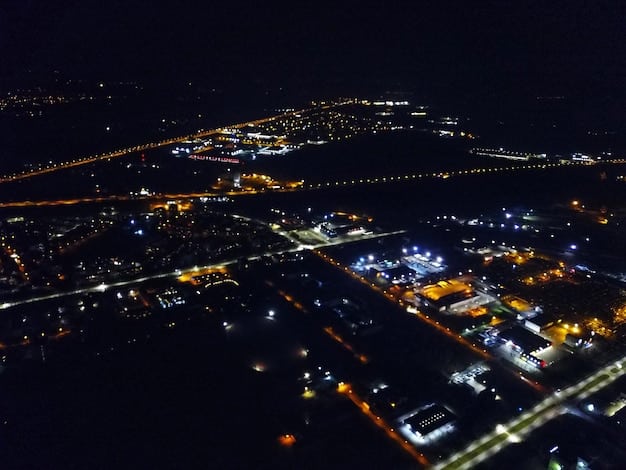Smart Street Lighting: Save 40% on Energy with LED Conversions

Smart street lighting leverages LED technology and intelligent controls to offer cities substantial energy savings, potentially reaching up to 40%, while enhancing public safety and enabling various smart city applications.
Imagine cutting your city’s energy bills by nearly half simply by upgrading the streetlights. That’s the promise of smart street lighting: How Cities Can Save Up to 40% on Energy Bills with LED Conversions, a technology that’s transforming urban landscapes and budgets.
The Dawn of Smart Street Lighting: An Overview
Traditional street lighting systems are often energy hogs, operating at full brightness regardless of actual need. Smart street lighting offers a more intelligent and efficient alternative. These systems use LED technology, coupled with sensors and networking capabilities, to optimize lighting levels and energy consumption.
By dimming lights when there’s no pedestrian or vehicle traffic, and by turning lights on or off based on real-time conditions, cities can achieve significant cost savings and reduce their carbon footprint. The transition to smart street lighting isn’t just about changing bulbs; it’s about creating a more responsive and sustainable urban environment.

Key Components of a Smart Street Lighting System
Several technologies work together to make smart street lighting systems effective and efficient.
- LED Luminaires: These lights are far more energy-efficient than traditional high-pressure sodium (HPS) or metal halide lamps. They also have a longer lifespan, reducing maintenance costs.
- Sensors: These devices detect motion, ambient light, and even environmental conditions like temperature and humidity.
- Networking and Communication: Smart streetlights are connected through wireless networks, allowing for remote monitoring, control, and data collection.
- Control Systems: Software platforms are used to manage the lighting system, analyze data, and optimize performance.
This integration allows for granular control over each streetlight, enabling cities to adapt lighting to specific needs and conditions.
Smart street lighting is more than just a replacement for old lights; it’s a comprehensive system that revolutionizes how cities manage their public lighting infrastructure, creating safer, more efficient, and more sustainable urban spaces.
The Energy Savings Potential: A Deep Dive
The primary appeal of smart street lighting lies in its remarkable energy savings potential. Cities converting to LED-based smart streetlights can typically expect to see energy consumption drop by 40% or more. This reduction translates directly into significant cost savings on electricity bills and reduced greenhouse gas emissions.
Beyond the inherent efficiency of LEDs, smart controls contribute further to energy conservation. By dimming lights during off-peak hours or in areas with low traffic, energy usage can be minimized without compromising safety.
How LED Conversions Drive Down Energy Costs
LEDs are inherently more efficient than traditional lighting technologies.
- Higher Lumens per Watt: LEDs produce more light per unit of energy consumed.
- Directional Lighting: LEDs emit light in a specific direction, reducing light pollution and waste.
- Longer Lifespan: LEDs last much longer than traditional bulbs, reducing replacement frequency and associated costs.
These factors combine to deliver substantial energy savings compared to older lighting systems.
Smart street lighting systems are showing results in many cities and bringing energy savings, reduced costs, and helping contribute to a sustainable environment for the world.
Beyond Energy: Additional Benefits of Smart Street Lighting
While energy savings are a major driver for adopting smart street lighting, these systems offer a multitude of other benefits that enhance urban life. These include improved safety, enhanced data collection, and integration with other smart city initiatives.
Smart streetlights can serve as a platform for a wide range of smart city applications, transforming them into versatile infrastructure assets.

Enhanced Safety and Security
- Improved Visibility: LEDs provide brighter, more uniform lighting, enhancing visibility for drivers and pedestrians.
- Adaptive Lighting: Smart controls can automatically increase lighting levels in response to detected motion or emergencies.
- Crime Deterrence: Well-lit streets can deter crime and improve residents’ sense of security.
Enhanced visibility ensures that law enforcement has the ability to respond quickly, preventing problems and reducing the risk.
Smart street lighting is more than just about saving energy; it’s about creating safer, more livable, and more connected communities, which ultimately benefits the economy.
The Financial Case: Calculating ROI and Funding Options
Implementing smart street lighting requires an upfront investment, but the long-term financial benefits often outweigh the initial costs. Calculating the return on investment (ROI) involves considering energy savings, reduced maintenance costs, and potential revenue streams from smart city applications.
Cities have several funding options available, including energy performance contracts, grants, and public-private partnerships.
Understanding the ROI of Smart Street Lighting
To accurately assess the financial feasibility, cities should perform a thorough cost-benefit analysis.
- Estimate Energy Savings: Calculate the potential savings based on current energy consumption and LED efficiency gains.
- Factor in Maintenance Reductions: Account for the longer lifespan of LEDs and reduced maintenance requirements.
- Consider Smart City Revenue: Explore potential revenue streams from ancillary services like public Wi-Fi or sensor data.
By quantifying these benefits, cities can build a compelling financial case for smart street lighting investments.
Cities can save money and reduce maintenance costs as a result of implementing smart street lighting.
Overcoming Implementation Challenges
While the benefits of smart street lighting are clear, implementing these systems can present several challenges. These include technology integration issues, data privacy concerns, and the need for community engagement.
Careful planning and proactive communication are crucial for overcoming these hurdles and ensuring a successful deployment.
Addressing Key Challenges
- Technology Compatibility: Ensure that different components of the system are compatible and can communicate effectively.
- Data Security: Implement robust data security measures to protect sensitive information.
- Community Engagement: Involve residents in the planning process to address their concerns and build support for the project.
Addressing these challenges proactively can pave the way for a smooth and successful transition to smart street lighting.
Smart street lighting implementation challenges can be solved with careful planning, proactive communication, and commitment to the technology.
The Future of Urban Lighting: Trends and Innovations
The field of smart street lighting is constantly evolving, with new technologies and innovations emerging regularly. Trends include the integration of 5G connectivity, the use of artificial intelligence (AI) for predictive maintenance, and the development of more sophisticated sensor capabilities.
These advancements promise to further enhance the efficiency, functionality, and impact of smart street lighting systems.
Emerging Trends in Smart Street Lighting
- 5G Connectivity: Faster and more reliable wireless communication for enhanced data transmission and control.
- AI-Powered Analytics: Predictive maintenance and optimized lighting based on real-time conditions.
- Advanced Sensors: Integration of sensors for air quality monitoring, traffic management, and public safety applications.
These trends show that smart street lighting is not just about saving energy, but also about creating more intelligent, responsive, and sustainable urban environments.
As smart street lighting continues to grow, cities will see reduced costs as well as improvements in infrastructure and crime prevention.
| Key Aspect | Brief Description |
|---|---|
| 💡 LED Efficiency | LEDs offer higher lumens per watt and longer lifespan, reducing energy use. |
| 🌃 Safety Enhancement | Improved visibility deters crime and enhances pedestrian and driver safety. |
| 📡 Smart Integration | Smart streetlights integrate with other smart city applications for broader impact. |
| 💰 Financial Savings | Reduced energy and maintenance costs lead to a strong ROI for cities. |
Frequently Asked Questions
▼
Cities can typically save up to 40% on their energy bills by converting to LED streetlights, due to the greater efficiency and longer lifespan of LED technology compared to traditional lighting.
▼
Beyond energy savings, smart street lighting offers enhanced safety, improved visibility, data collection capabilities, and integration with other smart city initiatives like traffic management and environmental monitoring.
▼
The key components include LED luminaires, sensors to detect motion and ambient light, networking and communication systems for remote control, and control systems for managing the lighting infrastructure.
▼
Cities can explore various funding options such as energy performance contracts, government grants, public-private partnerships, and leveraging savings from reduced energy and maintenance costs over time.
▼
Challenges can include ensuring technology compatibility, addressing data privacy concerns, securing community support, and effectively managing the integration of the new lighting system with existing infrastructure.
Conclusion
Smart street lighting: How Cities Can Save Up to 40% on Energy Bills with LED Conversions is more than a trend; it’s a practical solution for cities seeking to reduce energy consumption, improve safety, and embrace smart city technologies. By understanding the benefits, addressing the challenges, and exploring the innovative technologies in this field, cities can illuminate a brighter, more sustainable future for their residents.





